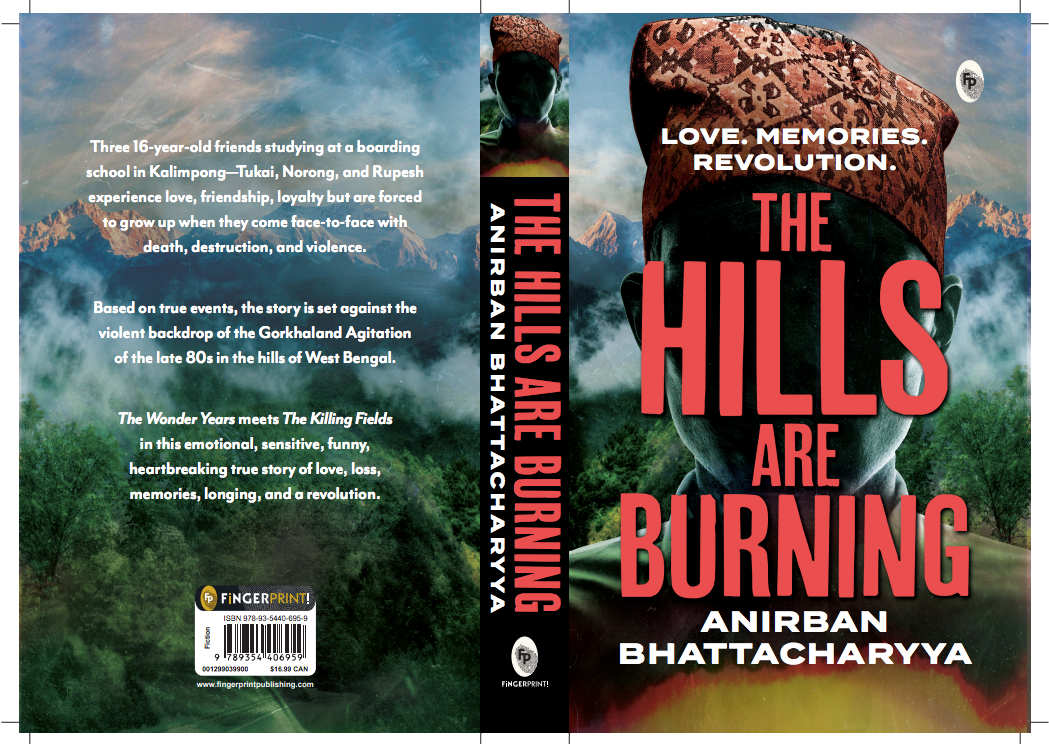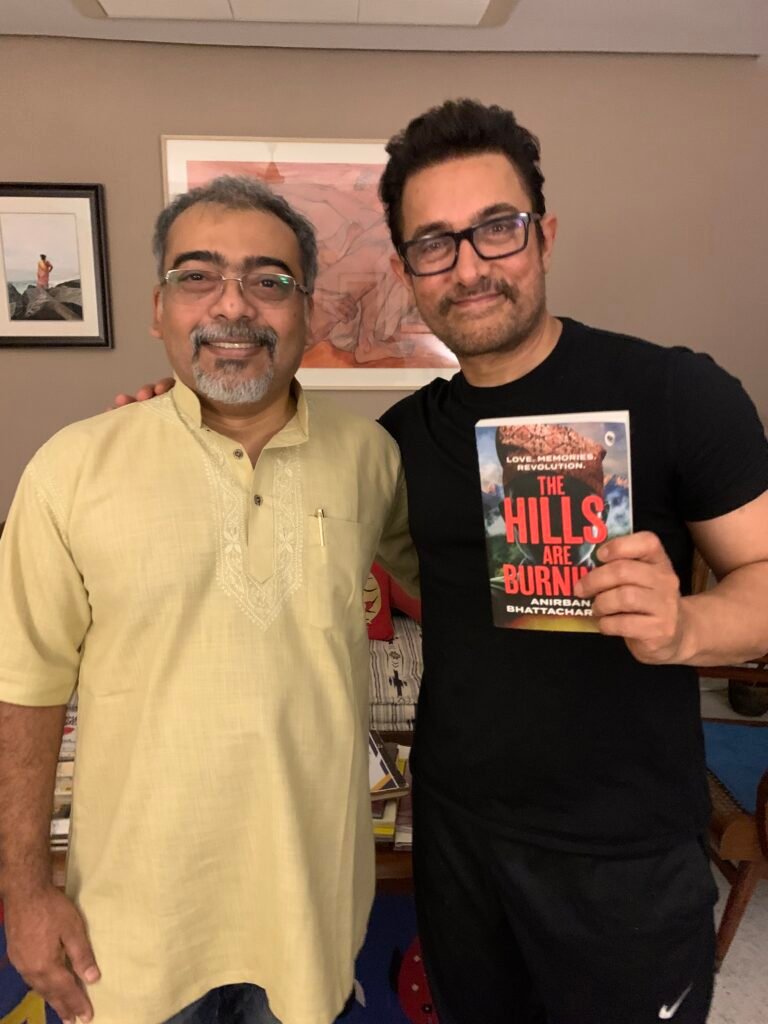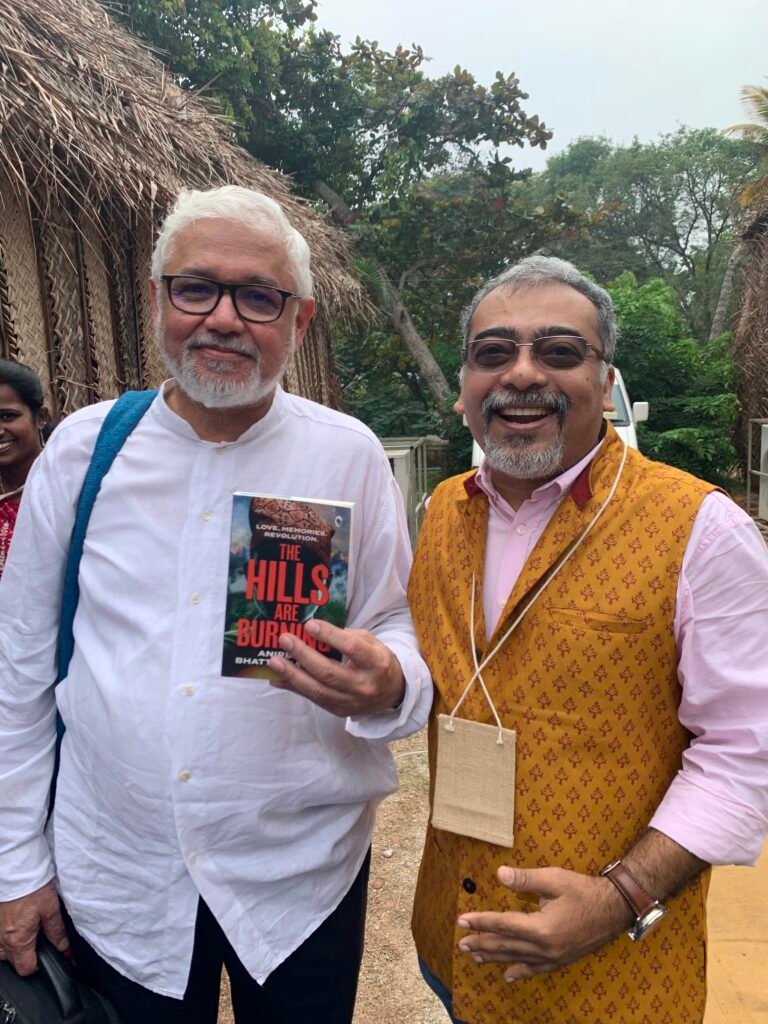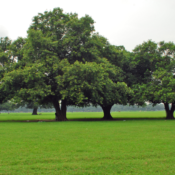
A BESTSELLING MEMOIR ABOUT LOVE, MEMORIES &KALIMPONG & THE GORKHALAND REVOLUTION
Bestselling Kolkata-Mumbai author Anirban Bhattacharyya who is
the Creator-Producer of the hit TV show Savdhaan India and
Producer of Crime Patrol is back with his fifth book. Known for his
bestselling true crime books The Deadly Dozen and India’s Money
Heist he delves into his own childhood to bring this semi-memoir
called The Hills Are Burning (Fingerprint). The book is the true
bittersweet, coming-of-age story about three friends growing up in
a boarding school in Kalimpong, set against the genesis and the
subsequent violence of the Gorkhaland Revolution of 1986, and
the human rights violations. The book is already a huge hit and its
second print run has been commissioned.
- What was your reason for writing this memoir – was it for
personal reasons or to capture that political era?
Both personal and socio-political. One of the primary reasons
behind writing this book was to document the events, the history
and the suffering before it all vanished from the collective memory
and conscience of the people. We are amongst the last few
remaining generations who saw the genesis of the revolution or
the andolan (called agitation by the Govt to control the narrative) in - The generation of today have grown up hearing the stories –
but the stories have become a blind-spot, an urban legend or
hearsay. Many of the incidents had been erased, denied, modified
by the then Govt to suit its own narrative and agenda. And I
wanted to excavate these true, heartbreaking stories of sacrifice
and suffering and share it with the world – so that they are not
forgotten. And the personal reason was to capture our growing up
years of friendship in the boarding school as a tribute to my friends
and school. This is a book dedicated to Kalimpong and her people. - You witnessed the Gorkhaland agitation from close
quarters as a young person. But now when you look back,
after all these years, what is your takeaway, given that fresh
demands for Gorkhaland are being made again?
The demand for Gorkhaland is over 100 years old. But since its
resurgence in 1986 under Subhash Ghising, from my layman
understanding, the Gorkhaland movement has become cyclical in
nature. Every decade there is an awakening and demand. And
every time there is violence, protests followed by some new
appeasement or diplomatic outcomes that douses the anger
temporarily. My takeaway is simple. Politics and politicians have
come and gone and will come and go; but in the end it is the
ordinary people who have suffered and will continue to suffer and
pay the price. Speeches, false promises, oratorial skills do not
generate jobs, or fill stomachs. And there has even been an
awakening amongst authors connected to the hills as 4 or 5 books
on Gorkhaland have been published in the last 12 months in
mainstream publishing. So my book is not to arouse political
fervour but to show the world the true story of what happened and
how the people suffered.
- You have written it as a fiction styled narrative – and it is a
beautiful and emotional love story as well… and the language
is languid!
If I had written an academic thesis or report or a political book the
readership would have been limited to intellectuals, political
analysts or political history students. So this book was about
Gorkhaland and Kalimpong, as much as it was about the friends
and boarding school life. Both the true stories or tracks are like
chalk and cheese – love and violence, peace and unrest clash
against each other which provides a rude awakening to the
teenage boys who realize that there is life outside the safety and
comforts of the boarding school – and that life is tough. The love
stories are true and what I experienced and all the incidents and
stories that you will read in the book are true. So a fiction style
narrative of a non-fiction book engages the reader. And this has
always been my writing style if you read my true crime books as
well. The book is nearly 400 pages but readers have messaged
me saying they have finished it in one or two sittings. - While the plot premise might sound very serious, you have
managed to infuse many little pockets of humour in the
narrative. Does humour come naturally to you?
I am a standup comedian and humour needed to be there in the
narrative. All seriousness would not have made the reader
empathize with the characters. So the book is filled with brilliant
touches of humour about our Bengali traits and idiosyncracies.
And the humour also helps me to show a lot of the interactions
between the characters – which may appear serious but the irony
is hilarious.

- In the book you have written dialogues in multiple
languages. Why?
I love being vocal for local. It brings a huge amount of authenticity
to the story especially as these are true stories. My first book about
the serial killers of India (The Deadly Dozen) had dialogues in 9
Indian languages as per the region where the crime had occurred.
My next book India’s Money Heist set in Kerala about India’s
biggest bank heist has dialogues in Malayalam. I enjoy the fact
that readers will be mouthing these new languages and thereby
breathing and living the character. This book has dialogues in
Bangla, English, Nepali, Rongring, Bhutanese and Tibetan. I want
to be as authentic as possible. - The book has already been a huge hit – what has been the
reaction?
I feel completely blessed and grateful that people have embraced
the book, especially the people of the hills. I think the acceptance
is because for the first time there has been correct and true
representation of the people, the culture and the facts about the
revolution which was filled with human rights violations, which was
completely glossed over in the last book on kalimpong and the
revolution. An outsider pretending to be an insider will never be
authentic. I have lived for 9 years there in the thick of things. My
friends and I have experienced first-hand. So the people of the hills
have embraced it. The book has hit No.1 on the Amazon
Bestseller List in India, Australia and the USA! And I feel blessed
that the reviews have been very generous! - Some of the incidents are truly horrific, shocking and
heartbreaking, and yet the book is such an emotional roller-
coaster.
The incidents are all true and I have described them without
censorship – like the heinous way in which they happened. It is to
shock the readers out oftheir apathy and also to make them aware
of what truly happened. And the book is very emotional. I
remember once I had completed it – I broke down as I felt so
empty and drained like a weight had lifted off. And my friends
whose stories are in the book have all had a cathartic experience
trying to recalland relive the memories. It is a book written from the
heart in the hope to hold on to precious memories.
- Your last crime book India’s Money Heist: The Chelembra
Bank Robbery was launched by Mohanlal. And this book is
being read by some heavy-duty literary and screen people?
IMH is the true story of India’s biggest bank heist which I have
written with P. Vijayan who is the IG of Kerala and who had solved
the case. And it was a dream launch with superstar Mohanlal sir
launching the book. Was completely blessed and grateful.
The Hills Are Burning has reached Booker Prize winner Shehan
Karunatilaka and also my literary Guru Amitav Ghosh – both of
whom I met at the Kerala Lit Fest. The book is also being read by
superstars Aamir Khan, Prosenjit Chatterjee, avid reader and
actress Sonali Bendre, my college friend Director and Producer
Kiran Rao and friend and actor Sushant Singh. - Why should people read the book?
It is an emotional true story about love, friendship, loyalty, growing
up, coming-of-age, death, loss, longing, memories and grief all set
against the epic true story of the Gorkhaland revolution as it
erupted in 1986. And I am completely thankful to the team at
Fingerprint Publishing of Shantanu Duttagupta and Sarita Prasad,
and to my literary agent Suhail Mathur of The Book Bakers for
taking this book into the world. - So, what’s next?
I have a horror anthology coming up, a true crime book, a fiction
and a celebrity autobiography.
BUY THE BOOK: https://www.amazon.in/dp/9354406955
SEE THE TRAILER: https://youtu.be/sD0EuO5XjbQ
Follow Anirban at www.linktr.ee/anirbanb
Facebook: @booksbyanirban
Instagram: @author_anirban




